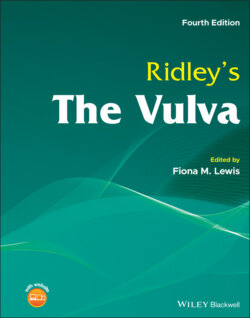Читать книгу Ridley's The Vulva - Группа авторов - Страница 69
Associated structures The vagina
ОглавлениеThe vagina is a fibromuscular tube about 7–10 cm long. It opens on the vulval vestibule and extends upwards and backwards, to be attached just above the lower margin of the uterine cervix. As the long axis of the vagina forms a right angle with the long axis of the normal anteverted uterus, the cervix projects downwards and backwards into the upper vagina. The vaginal fold around the periphery of the cervix is divided into anterior, posterior, and lateral fornices. The posterior wall of the vagina is about 2 cm longer than the anterior wall, but they are in contact with each other in the un‐distended vagina. This gives the vagina a crescentic or H‐shaped appearance in cross‐section. The outer wall of the vagina contains its vascular, lymphatic, and nerve supply.
The vagina is related anteriorly to the base of the bladder and to the urethra, which is embedded in its anterior wall. Posteriorly, the upper part of the vaginal wall is covered with peritoneum, and below the rectouterine pouch it is directly related to the ampulla of the rectum. In the perineum, it is separated from the anal canal by the perineal body (Figure 2.11). The upper vagina gives attachment to the uterosacral ligaments posteriorly, the cardinal or transverse ligaments laterally, and the base of the bladder anteriorly, which itself is supported by the pubovesical ligaments. As the vagina passes through the pelvic floor, the most medial fibres of the pubococcygeus blend with its walls to form a supporting muscular sling. Below the pelvic floor the vagina is supported by the urogenital diaphragm, the perineal body, and the perineal musculature. Thus, the vagina has three compartments:
Figure 2.11 Midline section through pelvis and perineum.
upper, above the pelvic floor and related to the rectum
middle, which traverses the pelvic floor and urogenital diaphragm
lower in the perineum.
